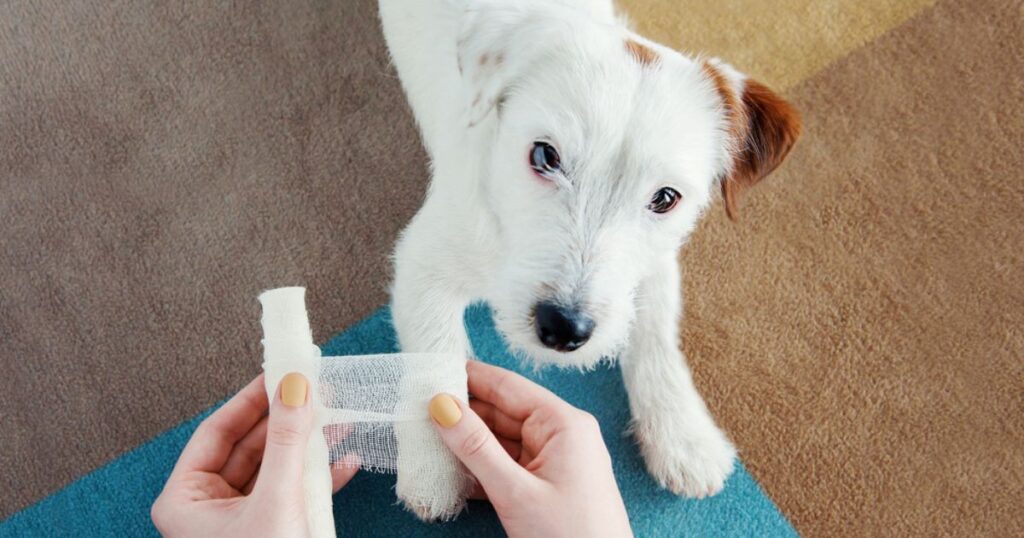Key Points
- Pet parents should have a “go” bag ready at all times.
- Get your pet microchipped now and take pictures together so you’ll have them in an emergency.
- Find out if local shelters accept pets, or if there are hotels along evacuation routes that will let your whole family stay.
When Ollie the cat was evacuating Florida during Hurricane Milton last year, he had a cozy spot in the front seat of his family’s car — and an adorably aloof cat-like reaction to a dog whose family was also evacuating the state’s Gulf Coast.
Ollie’s family was clearly prepared to leave their home in an emergency (they even had snacks!), but not all pet parents think that far in advance.
@livtok98 Love seeing everyone taking their pets with them while evacuating! ❤️ #hurricanemilton ♬ original sound – Olivia
“Whether from a fire, earthquake, or another disaster, a normal day can be transformed into an emergency situation in seconds,” says Dr. Laura Veals, DVM, associate emergency veterinarian at VEG ER for Pets in Beaverton, Oregon. “That’s why it’s critical for pet parents to create a pet-specific emergency plan before disaster strikes.”
To learn how to keep your pet safe when you’ve got to move fast, Pumpkin spoke with Dr. Veals as well as Dr. Mondrian Contreras, DVM, from Carol Stream Animal Hospital, in Illinois; Clara Pelton, the practice manager and leadership coach at Palms & Paws Veterinary Center in Santa Monica; and Myra Herbert-McHenry, RVT, the practice manager at the Companion Animal Wellness Center in Carlsbad, California.
Pet disaster preparedness: What to do right now
It’s an unfortunate fact of life, but wildfires, floods, hurricanes, tornadoes, and other natural disasters are on the rise, due to climate change. That means it’s more important than ever to have an action plan so that your dog or cat can evacuate with you.
“With the recent devastation of the California wildfires, we learned that emergencies could happen to anyone at any time,” Pelton says. “As pet parents, it is our responsibility to keep them safe and avoid harm.”
Your action plan should include an always-ready “go” bag, evacuation routes, important phone numbers, and a microchip for your pet, which you can get during a routine vet visit. By some estimates, dogs with microchips are returned to their owners at a rate of about 52%, higher than the non-microchipped rate of 21.9%.
“Having your pets microchipped and keeping the information current is so important in case of inadvertent separation,” Herbert-McHenry says. “Emergency services will try and reunite animals with their family if they have a chip.”
Also consider what would happen if your community needs to evacuate when you aren’t home — but your pet is. One smart option is to have a neighborhood buddy system.
“Choose someone you trust and make sure they have access to your home and are familiar with it,” Dr. Contreras says. “Go over situations with them and discuss an emergency plan along with any special instructions that relate to your pet.”
Now is also the time to invest in pet insurance, as it can be a literal lifesaver if there’s a natural disaster and your pet is injured. Vet bills, particularly during emergency situations, can climb into the thousands, so it’s essential that you can confidently give the veterinarian the OK to proceed with any treatment needed.
You can also read up now on the best tips for keeping your pet healthy in general in different seasons, like summer and winter — helpful if you’re evacuating during a heatwave or blizzard.
And if your pet has anxiety, now is also the time to ask their vet for a prescription that could help them relax in an emergency.
Create a pet emergency kit — aka a ‘go’ bag
One other major thing to do right now? Create a pet disaster kit, also known as a “go” bag.
Here is a pet disaster checklist of items you should always have ready to go, according to the American Red Cross and Ready.gov:
- A leash or harness (for dogs) and a carrier (for cats)
- An ID tag
- Food, drinking water, and bowls
- A litter box and pee pads
- Medications and medical records in a waterproof container
- Photos of your pet in case they get lost (take photos of you together, if you can, to help establish that your pet belongs to you, when found)
- Pet beds and toys, if easily transportable
- A first aid kit
“Sometimes these items and plans can be the difference between life and death,” Pelton says.
And if you have room in your cat or dog survival kit, snacks are never a bad idea. “Shelf-stable treats, like a jar of peanut butter, and washable pet lick mats are easy to pack and last a long time,” Dr. Veals adds.
You’ll want to make sure your first aid kit includes:
- Gauze
- Nonstick bandages
- Adhesive tape
- Antiseptic wipes
- Saline solution
- Tweezers
- A digital thermometer
- Scissors
- Gloves
What to do in an emergency evacuation

Once an emergency strikes, you’ll want to grab your “go” bag, then follow your evacuation route.
This smart family had a plan when they needed to evacuate during Hurricane Helene, and they arrived safely at a pet-friendly hotel. Though the cats weren’t so excited about the whole thing, their dog was delighted by the soft bed.
Dr. Contreras notes that you should check ahead of time to see if shelters near you accept pets in an emergency, and you can also phone hotels on your evacuation route to see if they’ll let the whole family stay. (Some hotels that don’t usually allow pets might bend the rules in an emergency.)
Dr. Veals notes the organization Red Rover often finds temporary homes for displaced animals in an emergency.
One often-overlooked aspect of an evacuation is keeping your pet calm and feeling safe, which is hard to do when you might be freaking out yourself.
“Pets are incredibly intuitive — they absorb our energy and emotions like little sponges,” Dr. Veals says. “Speak to them in a reassuring tone, use their familiar cues, and keep them close in either a carrier or crate or on a leash.”
Know basic pet first aid
If the worst happens and your pet ends up injured, you’ll thank yourself for learning first aid ahead of time (and packing all those supplies in your “go” bag) to ease your dog or cat’s pain.
While most emergencies need a veterinarian, there are things you can do to minimize some injuries en route to the ER vet. You should always try to stop any bleeding, for example.
“Using a clean cloth or towel to apply firm pressure directly over a wound can help staunch any bleeding,” Dr. Veals says.
Burns are another area where you can help.
“Especially critical during a fire evacuation, pet parents can help provide burn relief by flushing the burn with lukewarm water and then covering it with a damp, room-temperature towel on their way to the ER,” she notes.

(You can add a towel or two to your cat or dog emergency kit if you have room.)
If your dog has a broken bone, always try to transport them on a flat surface; consider making a splint with a straight piece of wood applied with a bandage—then get them to an emergency veterinarian, stat.
Dr. Veals recommends learning how to give your dog or cat CPR, too, and suggests the RECOVER Certified Pet Rescuer Program to give you a leg up when you need to do it in a pinch.
Be prepared for your pet now, not later
Right now, disaster preparedness for pets might seem like a faraway possibility, and it might even seem silly to prepare for it—after all, who wants to ruin a lovely day with thoughts of chaos?
“It can definitely be hard to think through contingencies that could involve the loss of your home or treasured belongings, but preparing in advance is the best way to ensure that those closest to you will remain safe even in the worst of circumstances, including pets,” Dr. Veals says. “Even just a few hours of preparation now can make all the difference down the line.”
Adds Hurbert-McHenry, “I feel about having a disaster kit like I do about pet insurance or health insurance for myself: I have it in hopes I never have to use it, but when I have to use it, I am so grateful to have it.”



